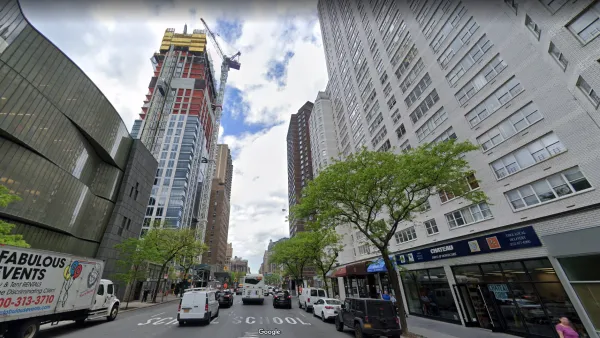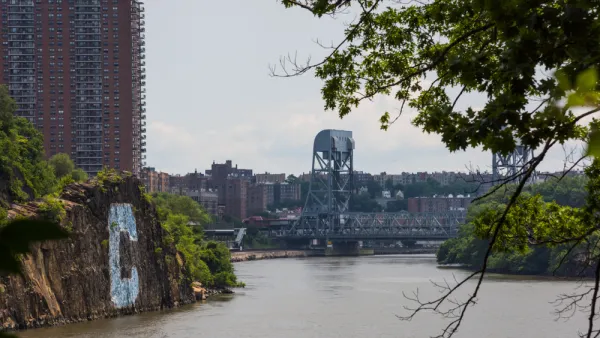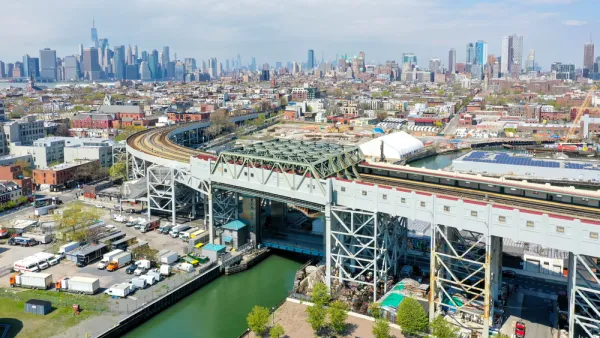New York's 1916 zoning code would not have allowed 40 percent of buildings in Manhattan to be built today, according to a recent analysis. It also turns 100 on August 27 of this year.
"New York’s zoning code was the first in the country, meant to promote a healthier city, which was then filling with filthy tenements and office towers," write Quoctrung Bui, Matt A.V. Chaban, and Jeremy White for The New York Times' "Upshot."
That assessment is reinforced in the introduction of a May 20 Wall Street Journal book review, "In Praise of Urban Sprawl," regarding Joel Kotkin's The Human City: "The New York Times in 1898 spoke of 'densely crowded quarters' and 'inmates . . . huddled together in their cramped hutches like rabbits',” writes Shlomo Angel. Zoning codes sought to improve city living conditions without having to resort to the sprawl that Kotkin praises. [See book review of "The Human City" by Planetizen contributor, Josh Stephens.]
"Since it was approved in 1916, the ever-evolving, byzantine code has changed many times to suit the needs of a swollen metropolis," write Bui, Chaban, and White.
Just in March, the administration of Mayor Bill de Blasio won approval for a vast citywide plan that would encourage sleeker, more affordable developments. As the zoning code enters its second century, it is worth considering the ways it has shaped the city; whether and where it is still working; and how it might be altered so the city can continue to grow without obliterating everything New Yorkers love about it.
The 40 percent finding comes from an analysis made by Quantierra, "a real estate firm that uses data to look for investment opportunities."
Many buildings in distinctive Manhattan neighborhoods like Chinatown, the Upper East Side and Washington Heights could not be erected now: Properties in those areas tend to cover too much of their lots (Washington Heights), have too much commercial space (Chinatown) or rise too high (the Upper East Side). Areas like Chelsea, Midtown and East Harlem, on the other hand, would look much as they do already.
“Look at the beautiful New York City neighborhoods we could never build again,” said Mr. Stephen Smith, a co-owner of Quantierra. “It’s ridiculous that we have these hundred-year-old buildings that everyone loves, and none of them ‘should’ be the way they are.”
The reporters describe the various attractive buildings, with photos, that predate the 1916 zoning code, and the reasons why city planners altered the zoning code to make those buildings illegal. They consider the downside of the ever-more restrictive zoning codes. Explore Manhattan on this interactive map by placing your browser over areas and see which of four reasons would prevent existing buildings from being constructed.
"In honor of the code’s 100th anniversary, the Municipal Art Society of New York has called on City Hall to consider overhauling the code in a way that would make it intelligible to all," write Bui, Chaban, and White. See related Planetizen post in 2011.
“To understand zoning, you have to have a law degree, it’s so convoluted and so dense,” Mike Ernst, director of planning at the civic group, said. “The whole process of how buildings get built these days is so confusing and opaque to people. There really should be more transparency, so people can have an understanding of what the future holds for their city.”
FULL STORY: 40 Percent of the Buildings in Manhattan Could Not Be Built Today

Analysis: Cybertruck Fatality Rate Far Exceeds That of Ford Pinto
The Tesla Cybertruck was recalled seven times last year.

National Parks Layoffs Will Cause Communities to Lose Billions
Thousands of essential park workers were laid off this week, just before the busy spring break season.

Retro-silient?: America’s First “Eco-burb,” The Woodlands Turns 50
A master-planned community north of Houston offers lessons on green infrastructure and resilient design, but falls short of its founder’s lofty affordability and walkability goals.

Test News Post 1
This is a summary

Analysis: Cybertruck Fatality Rate Far Exceeds That of Ford Pinto
The Tesla Cybertruck was recalled seven times last year.

Test News Headline 46
Test for the image on the front page.
Urban Design for Planners 1: Software Tools
This six-course series explores essential urban design concepts using open source software and equips planners with the tools they need to participate fully in the urban design process.
Planning for Universal Design
Learn the tools for implementing Universal Design in planning regulations.
EMC Planning Group, Inc.
Planetizen
Planetizen
Mpact (formerly Rail~Volution)
Great Falls Development Authority, Inc.
HUDs Office of Policy Development and Research
NYU Wagner Graduate School of Public Service




























